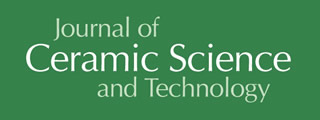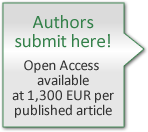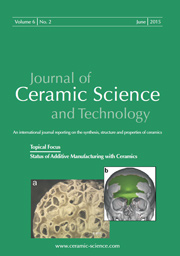Articles
All articles | Recent articles
Sol-Gel Synthesis of Strontium Titanate Nanofibers by Electrospinning
J. H. Roque-Ruiz1, J. Meraz-Angel1, R. Farias2, M. Meléndez-Lira3, S. Y. Reyes-López1
1 Instituto de Ciencias Biomédicas, Universidad Autónoma de Ciudad Juárez, Envolvente del PRONAF y Estocolmo s/n, Ciudad Juárez, Chih., México C.P. 32300
2 Instituto de Ingeniería y Tecnología, Universidad Autónoma de Ciudad Juárez, Av. del Charro No. 450 Nte. Col. Partido Romero C.P. 32310
3 Physics Department, CINVESTAV-IPN, Apdo. Postal 14 – 740 México, D.F. 07360, México
received June 28, 2018, received in revised form February 28, 2019, accepted March 15, 2019
Vol. 10, No. 1, Pages 29-38 DOI: 10.4416/JCST2018-00072
Abstract
The preparation of homogeneous SrTiO3 nanofibers has been difficult and there are few publications in this field. In this research, consistent structures of strontium titanate ceramic fibers were obtained using an easy sol-gel and electrospinning methodology, giving an alternative for preparing ceramics in the form of fibrillar membranes. Two sol-gel solutions starting from Strontium nitrate and titanium tetraisopropoxyde were prepared and then mixed and homogenized with polyvinylpyrrolidone polymeric solution. The green fibers obtained from the ceramic precursors had a diameter of 140 to 180 nm. At 1000 °C the shape of fibers was preserved, with mean diameter of 103±39 nm. Based on the thermal analysis, the phase transition from tetragonal titanium oxide to the perovskite structure of strontium titanate was determined to take place at 800 °C. By infrared spectroscopy, Raman spectroscopy and X-ray diffraction analysis, it was determined that ceramic fibers at 1200 °C had a perovskite structure characteristic of strontium titanate.
![]() Download Full Article (PDF)
Download Full Article (PDF)
Keywords
electrospinning, perovskite, sol-gel, strontium titanate.
References
1 Macaraig, L., Chuangchote, S., Sagawa, T.; Electrospun SrTiO3 nanofibers for photocatalytic hydrogen generation. J. of Mater. Res., 29, 123 – 130 (2014).
2 Klein, C., Hurlbut, C. S., Manual de mineralogía Vol. 2, Reverte, España (1996).
3 Roque-Ruiz, J. H., Cabrera-Ontiveros, E. A., Torres-Pérez, J., Reyes-López, S. Y (2016). Preparation of PCL/clay and PVA/clay electrospun fibers for Cadmium (Cd+2), Chromium (Cr+3), Copper (Cu+2) and Lead (Pb+2) removal from water. Water, Air, Soil Poll., 227, 286 (2016).
4 Li, D., Xia, Y., Electrospinning of nanofibers: Reinventing the wheel. Adv. Mater., 16, 1151 – 1170 (2004).
5 Bhardwaj, N., Kundu, S. C. Electrospinning: A fascinating fiber fabrication technique. Biotechn. Adv., 28, 325 – 347 (2010).
6 Reyes-López, S. Y., Cornejo-Monroy, D., González-García, G. A novel route for the preparation of gold nanoparticles in polycaprolactone nanofibers. J. of Nanomater., 16, 153 (2015).
7 López-Esparza, J., Espinosa-Cristóbal, L. F., Donohue-Cornejo, A., Reyes-López, S. Y., Antimicrobial activity of silver nanoparticles in polycaprolactone nanofibers against gram-positive and gram-negative bacteria. Ind. Eng. Chem. Res., 55, 12532 – 12538 (2016).
8 Garibay-Alvarado, J. A., Espinosa-Cristóbal, L. F., &. Reyes-López Y. S. Fibrous silica-hydroxyapatite composite by electrospinning. Int. J. Res. GRANTHAALAYAH. 5 (2017).
9 Llano, B., Marín, J. M., Restrepo, G., Ríos, L. A. Síntesis, caracterización y evaluación fotocatalítica de óxidos mixtos titanio-silicio. Sci. Techn., 1 (2007).
10 Yoshida, M., Prasad, P. N. Sol-gel-processed SiO2/TiO2/poly (vinylpyrrolidone) composite materials for optical waveguides. Chem. Mater., 8, 235 – 241 (1996).
11 Wang, X., Zhang, L., Liu, H., Zhai, J., Yao, X. Dielectric nonlinear properties of BaTiO3-CaTiO3-SrTiO3 ceramics near the solubility limit. Mater. Chem. Phys., 112, 675 – 678 (2008).
12 Nezarati, R. M., Eifert, M. B., Cosgriff-Hernandez, E., Effects of humidity and solution viscosity on electrospun fiber morphology. Tissue Eng. C, Methods, 19, 810 – 819 (2013).
13 Huan, S., Liu, G., Han, G., Cheng, W., Fu, Z., Wu, Q., Wang, Q., Effect of experimental parameters on morphological, mechanical and hydrophobic properties of electrospun polystyrene fibers. Mater., 8, 2718 – 2734 (2015).
14 Roque-Ruiz, J. H.; Medellín-Castillo, N. A.; Reyes-López, S. Y., Fabrication of α-alumina fibers by sol-gel and electrospinning of aluminum nitrate precursor solutions. Res. Phys. 12, 193 – 204 (2019).
15 Garibay-Alvarado, J. A., Farias, R., Reyes-López, S. Y., Sol-gel and electrospinning synthesis of lithium niobate-silica nanofibers. In press, Coatings, 9 (2019).
16 Uddin, M. E., Layek, R. K., Kim, N. H., Hui, D., Lee, J. H., Preparation and properties of reduced graphene oxide/polyacrylonitrile nanocomposites using polyvinyl phenol. Compos. B, Eng., 80, 238 – 245.M (2015).
17 Kong, J., Rui, Z., Ji, H., Carbon nitride polymer sensitization and nitrogen doping of SrTiO3/TiO2 nanotube heterostructure toward high visible light photocatalytic performance. Ind. Eng. Chem. Res., 56, 9999 – 10008 (2017).
18 Tang, Y., Xie, L., Sai, M., Xu, N., Ding, D., Preparation and antibacterial activity of quaternized chitosan with iodine. Mater. Sci. Eng. C, 48, 1 – 4 (2015).
19 George, C. N., Thomas, J. K., Jose, R., Kumar, H. P., Suresh, M. K., Kumar, V. R., Koshy, J., Synthesis and characterization of nanocrystalline strontium titanate through a modified combustion method and its sintering and dielectric properties. J. Alloys and Comp., 486 (1 – 2), 711 – 715 (2009).
20 Tenne, D. A., Farrar, A. K., Brooks, C. M., Heeg, T., Schubert, J., Jang, H. W., Schlom, D. G., Ferroelectricity in nonstoichiometric SrTiO3 films studied by ultraviolet Raman spectroscopy. Appl. Phys. Lett., 97, 142901 (2010).
21 Ohsaka, T., Izumi, F., Fujiki, Y., Raman spectrum of anatase, TiO2. J. Raman spectroscopy, 7, 321 – 324 (1978).
22 Basiev, T. T., Sobol, A. A., Zverev, P. G., Osiko, V. V., Powell, R. C., Comparative spontaneous Raman spectroscopy of crystals for Raman lasers. Appl. Opt., 38, 594 – 598 (1999).
23 Hao, J. H., Gao, J., Wong, H. K., Laser molecular beam epitaxy growth and properties of SrTiO3 thin films for microelectronic applications. Thin Solid Films, 515, 559 – 562 (2006).
24 Singh, D. K., Manam, J., Optical spectroscopic and thermal quenching behaviour of perovskite SrTiO3: Sm3+ orange emitting phosphors for lighting applications. J. Mater. Sci.: Materials in Electronics, 29, 5579 – 5588 (2018).
25 Su, E. C., Huang, B. S., Wey, M. Y., Enhanced optical and electronic properties of a solar light-responsive photocatalyst for efficient hydrogen evolution by SrTiO3/TiO2 nanotube combination. Solar Ener., 134, 52 – 63 (2016).
26 Magalhães, R. S., Junior, W. D., Souza, A. E., Teixeira, S. R., Li, M. S., Longo, E., Synthesis of BaTIO3 and SrTIO3 by microwave assisted hidrotermal method (mah) using anatase as titanium precursor. Química Nova, 40, 166 – 170 (2017).
27 Zavala, M. Á. L., Morales, S. A. L., Ávila-Santos, M., Synthesis of stable TiO2 nanotubes: Effect of hydrothermal treatment, acid washing and annealing temperature. Heliyon, 3, e00456 (2017).
28 Roque-Ruiz, J. H., Martínez-Máynez, H., Zalapa-Garibay, M. A., Arizmendi-Moraquecho, A., Farias, R., Reyes-López, S. Y., Surface enhanced Raman spectroscopy in nanofibers mats of SiO2-TiO2-Ag. Res. Phys., 7, 2520 – 2527 (2017).
29 Dong, L., Luo, Q., Cheng, K., Shi, H., Wang, Q., Weng, W., Han, W. Q. Facet-specific assembly of proteins on SrTiO3 polyhedral nanocrystals. Sci. Rep., 4, 5084 (2014).
Copyright
Göller Verlag GmbH


